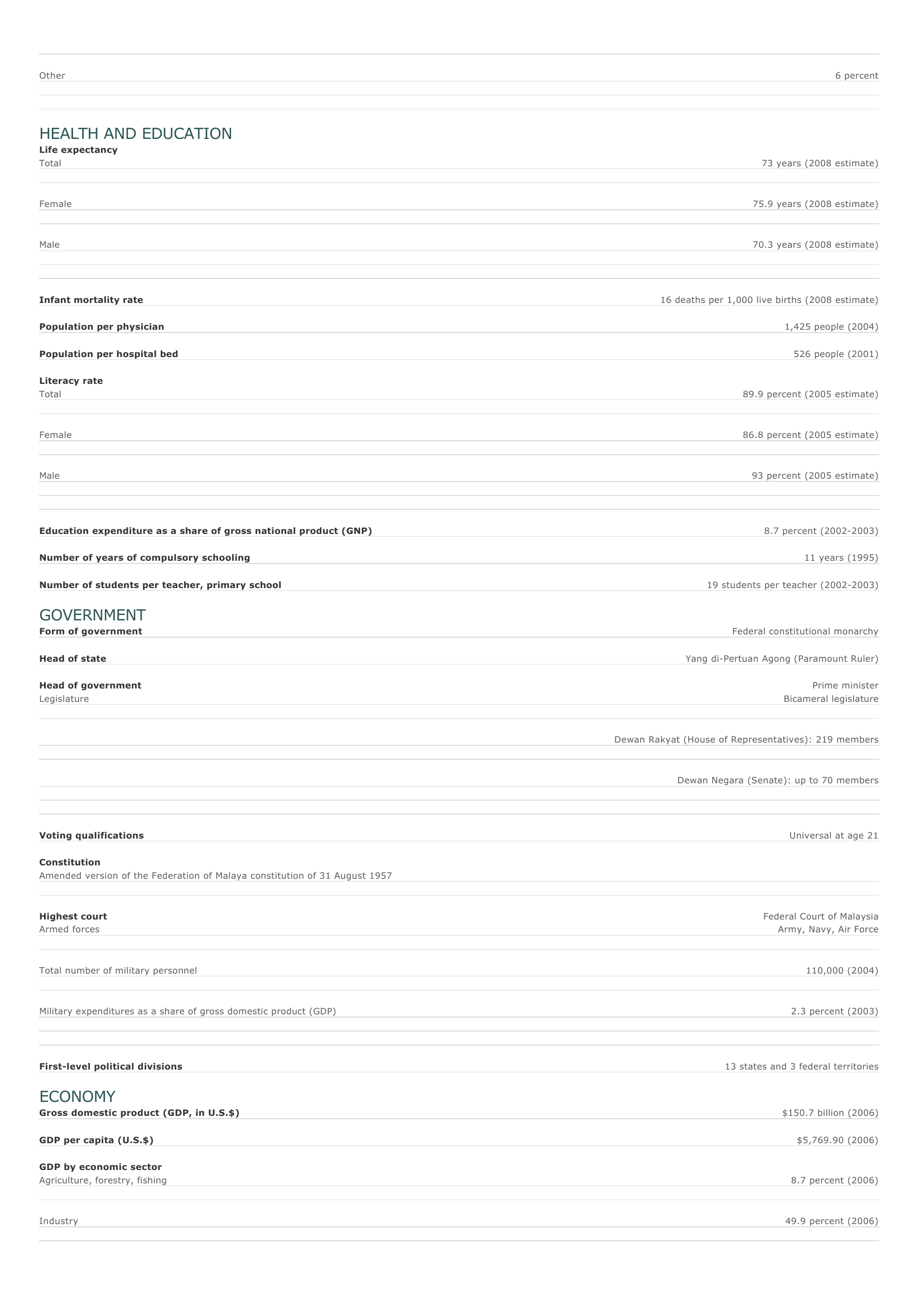Malaysia Facts and Figures. BASIC FACTS Official name Capital Area Federation of Malaysia Kuala Lumpur 329,758 sq km 127,320 sq mi PEOPLE Population 25,259,428 (2008 estimate) Population growth Population growth rate 1.74 percent (2008 estimate) Projected population in 2025 33,064,523 (2025 estimate) Projected population in 2050 43,122,397 (2050 estimate) Population density 77 persons per sq km (2008 estimate) 199 persons per sq mi (2008 estimate) Urban/rural distribution Share urban 65 percent (2005 estimate) Share rural 35 percent (2005 estimate) Largest cities, with population Kuala Lumpur 1,352,000 (2003 estimate) Ipoh 562,000 (2007 estimate) Kelang 996,000 (2007 estimate) Petaling Jaya 438,084 (2000) Johor Baharu 384,613 (2000) Ethnic groups Malays and other indigenous groups 65 percent Chinese 26 percent I ndian 8 percent O ther 1 percent Languages Bahasa Malaysia (official), Chinese (various dialects), English, Tamil, Iban, other indigenous languages Religious affiliations Muslim 48 percent Folk religions 24 percent Christian 8 percent Buddhist 7 percent Hindu 7 percent O ther 6 percent HEALTH AND EDUCATION Life expectancy Total 73 years (2008 estimate) Female 75.9 years (2008 estimate) Male 70.3 years (2008 estimate) Infant mortality rate Population per physician Population per hospital bed 16 deaths per 1,000 live births (2008 estimate) 1,425 people (2004) 526 people (2001) Literacy rate Total 89.9 percent (2005 estimate) Female 86.8 percent (2005 estimate) Male Education expenditure as a share of gross national product (GNP) Number of years of compulsory schooling Number of students per teacher, primary school 93 percent (2005 estimate) 8.7 percent (2002-2003) 11 years (1995) 19 students per teacher (2002-2003) GOVERNMENT Form of government Head of state Head of government Legislature Federal constitutional monarchy Yang di-Pertuan Agong (Paramount Ruler) Prime minister Bicameral legislature Dewan Rakyat (House of Representatives): 219 members Dewan Negara (Senate): up to 70 members Voting qualifications Universal at age 21 Constitution Amended version of the Federation of Malaya constitution of 31 August 1957 Highest court Armed forces Total number of military personnel Military expenditures as a share of gross domestic product (GDP) First-level political divisions Federal Court of Malaysia Army, Navy, Air Force 110,000 (2004) 2.3 percent (2003) 13 states and 3 federal territories ECONOMY Gross domestic product (GDP, in U.S.$) GDP per capita (U.S.$) GDP by economic sector Agriculture, forestry, fishing I ndustry $150.7 billion (2006) $5,769.90 (2006) 8.7 percent (2006) 49.9 percent (2006) Services Employment Number of workers 41.3 percent (2006) 11,594,023 (2006) Workforce share of economic sector Agriculture, forestry, fishing 15 percent (2004) I ndustry 30 percent (2004) Services 53 percent (2004) Unemployment rate 3.5 percent (2004) National budget (U.S.$) Total revenue $20,886 million (2003) Total expenditure $24,634 million (2003) Monetary unit 1 ringgit Malaysia (RM), consisting of 100 sen Agriculture Rice, palm oil, rubber, cacao, pepper, coconuts, pineapples, timber Mining Petroleum, natural gas, tin, bauxite, iron ore, copper Manufacturing Semiconductors and electronic products, wood products, refined petroleum, motor vehicles Major exports Semiconductors and electrical equipment, palm oil, chemicals, petroleum, machinery, wood and wood products, textiles Major imports Electrical and electronic products, machinery and transportation equipment, chemicals, manufactures of metal, petroleum, iron and steel products Major trade partners for exports United States, Singapore, Japan, Hong Kong SAR, and Netherlands Major trade partners for imports Japan, United States, Singapore, Taiwan, and China ENERGY, COMMUNICATIONS, AND TRANSPORTATION Electricity production Electricity from thermal sources Electricity from hydroelectric sources 92.65 percent (2003 estimate) 7.35 percent (2003 estimate) Electricity from nuclear sources 0 percent (2003 estimate) Electricity from geothermal, solar, and wind sources 0 percent (2003 estimate) Number of radios per 1,000 people 434 (1997) Number of telephones per 1,000 people 172 (2005) Number of televisions per 1,000 people 179 (2000 estimate) Number of Internet hosts per 10,000 people 43 (2003) Daily newspaper circulation per 1,000 people 163 (1996) Number of motor vehicles per 1,000 people 254 (2003) Paved road as a share of total roads 81 percent (2004) SOURCES Basic Facts and People sections Area data are from the statistical bureaus of individual countries. Population, population growth rate, and population projections are from the United States Census Bureau, International Programs Center, International Data Base (IDB) (www.census.gov). Urban and rural population data are from the Food and Agriculture Organization (FAO) of the United Nations (UN), FAOSTAT database (www.fao.org). Largest cities population data and political divisions data are from the statistical bureaus of individual countries. Ethnic divisions and religion data are largely from the latest Central Intelligence Agency (CIA) World Factbook and from various country censuses and reports. Language data are largely from the Ethnologue, Languages of the World, Summer Institute of Linguistics International (www.sil.org). Health and Education section Life expectancy and infant mortality data are from the United States Census Bureau, International Programs Center, International database (IDB) (www.census.gov). Population per physician and population per hospital bed data are from the World Health Organization (WHO) (www.who.int). Education data are from the United Nations Educational, Scientific and Cultural Organization (UNESCO) database (www.unesco.org). Government section Government, independence, legislature, constitution, highest court, and voting qualifications data are largely from various government Web sites, the latest Europa World Yearbook, and the latest Central Intelligence Agency (CIA) World Factbook. The armed forces data is from Military Balance. Economy section Gross domestic product (GDP), GDP per capita, GDP by economic sectors, employment, and national budget data are from the World Bank database (www.worldbank.org). Monetary unit, agriculture, mining, manufacturing, exports, imports, and major trade partner information is from the statistical bureaus of individual countries, latest Europa World Yearbook, and various United Nations and International Monetary Fund (IMF) publications. Energy, Communication, and Transportation section Electricity information is from the Energy Information Administration (EIA) database (www.eia.doe.gov). Radio, telephone, television, and newspaper information is from the United Nations Educational, Scientific and Cultural Organization (UNESCO) database (www.unesco.org). Internet hosts, motor vehicles, and road data are from the World Bank database (www.worldbank.org). Note Figures may not total 100 percent due to rounding. Microsoft ® Encarta ® 2009. © 1993-2008 Microsoft Corporation. All rights reserved.








